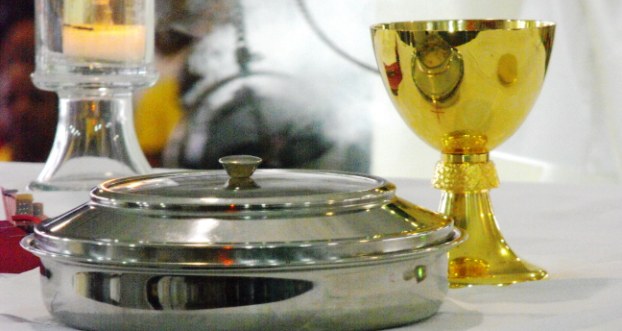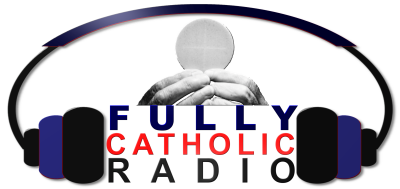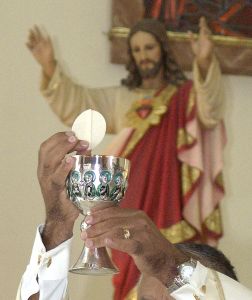Eucharist – An Introduction

(Greek eucharistia, thanksgiving).
The name given to the Blessed Sacrament of the Altar in its twofold facet of sacrament and Sacrifice of Mass, and where Jesus Christ is truly present under the bread and wine.
Various other titles are made use of, such as “Lord’s Supper” (Coena Domini), “Table of the Lord” (Mensa Domini), the “Lord’s Body” (Corpus Domini), and the “Holy of Holies” (Sanctissimum), to which may be added the following expressions, and somewhat changed from their primitive meaning: “Agape” (Love-Feast), “Eulogia” (Blessing), “Breaking of Bread”, “Synaxis” (Assembly), etc.; however the old title “Eucharistia” appearing in authors as very early as Ignatius, Justin, and Irenaeus, has taken precedence in the technical terms of the Church and her theologians. The expression “Blessed Sacrament of the Altar”, introduced by Augustine, is at the present day practically totally restricted to catechetical and popular treatises.
This extensive nomenclature, explaining the great mystery from such different perspectives, is in itself sufficient evidence of the central position the Eucharist has occupied from the earliest ages, both in the Divine worship and services of the Church and in the life of faith and devotion which animates her members.
The Church honors the Eucharist as one of her most exalted mysteries, since for sublimity and incomprehensibility it yields in absolutely nothing to the allied mysteries of the Trinity and Incarnation. These three secrets make up a wonderful triad, which causes the vital quality of Christianity, as a religion of mysteries far going beyond the capabilities of reason, to beam forth in all its brilliance and elegance, and raises Catholicism, the most devoted guardian and caretaker of our Christian heritage, far above all pagan and non-Christian religious beliefs.
The organic connection of this mysterious triad is plainly discerned, if we consider Divine grace under the aspect of a personal communication of God. Thus in the bosom of the Blessed Trinity, God the Father, by virtue of the eternal generation, interacts His Divine Nature to God the Son, “the only begotten Son who is in the bosom of the Father” (John 1:18), while the Son of God, by virtue of the hypostatic union, communicates in turn the Divine Nature got from His Father to His human nature formed in the womb of the Virgin Mary (John 1:14), in order that hence as God-man, concealed under the Eucharistic Species, He might deliver Himself to His Church, who, as a tender mother, mystically looks after and supports in her very own bosom this, her best treasure, and everyday places it before her children as the spiritual meals of their souls. Hence the Trinity, Incarnation, and Eucharist are really welded together like a valuable chain, which in a remarkable manner links paradise with earth, God with man, unifying them most intimately and keeping them therefore joined. By the extremely reality that the Eucharistic secret does go beyond reason, no rationalistic explanation of it, based upon a merely natural hypothesis and seeking to comprehend one of the sublimest facts of the Christian religious beliefs as the spontaneous conclusion of logical processes, might be tried by a Catholic theologian.
The modern-day science of comparative religion is striving, anywhere it can, to find in pagan religions “religio-historical parallels”, matching to the theoretical and practical aspects of Christianity, and hence by means of the previous to provide a natural explanation of the latter. Even were an analogy discernible between the Eucharistic repast and the ambrosia and nectar of the ancient Greek gods, or the haoma of the Iranians, or the soma of the ancient Hindus, we should nevertheless be very cautious not to extend a mere analogy to a parallelism strictly so called, since the Christian Eucharist has nothing at all in common with these pagan foods, whose origin is to be located in the crassest idol – and nature-worship. Just what we do specifically uncover is a brand-new evidence of the reasonableness of the Catholic religious beliefs, from the circumstance that Jesus Christ in a wonderfully condescending way replies to the natural yearning of the human heart after a meals which nourishes unto immortality, a yearning shown in many pagan religions, by dispensing to mankind His very own Flesh and Blood. All that is stunning, all that is true in the religions of nature, Christianity has actually appropriated to itself, and like a concave mirror has gathered the dispersed and not occasionally altered rays of naked truth into their common focus and again sent them forth resplendently in best beams of light.
It is the Church alone, “the pillar and ground of truth”, imbued with and directed by the Holy Spirit, that assurances to her children with her infallible training the unadulterated and complete revelation of God. It is the first task of Catholics to adhere to exactly what the Church proposes as the “proximate norm of faith” (regula fidei proxima), which, in reference to the Eucharist, is set forth in a particularly clear and in-depth way in Sessions XIII, XXI, and XXII of the Council of Trent.
The quintessence of these doctrinal choices consists in this, that in the Eucharist the Body and Blood of the God-man are really, really, and substantially present for the nourishment of our souls, by reason of the transubstantiation of the bread and wine into the Body and Blood of Christ, and that in this change of substances the unbloody Sacrifice of the New Testament is additionally included.
These 3 concept truths– Sacrifice, Sacrament, and Real Presence– are given a more in-depth factor to consider in the following posts:




